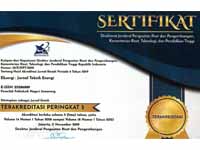OPTIMASI AERODINAMIKA BODI MOBIL HEMAT ENERGI KEN DEDES ELECTRIC EVO 3 MENGGUNAKAN METODE COMPUTATIONAL FLUID DYNAMICS (CFD)
DOI:
https://doi.org/10.32497/eksergi.v17i1.2219Keywords:
aerodynamics, ANSYS, enegy-efficient, fluid mechanics, simulationAbstract
Aerodynamics is a branch of science that discusses the movement of an object in the air. Aerodynamics comes from the words aero = air and dynamics = force of motion. The study of air forces is a branch of fluid mechanics. This study is a continuation of the study of hydrodynamics, where the science of the motion of air has a close relationship with other sciences. Physics, mathematics, mechanics, meteorology and others are branches of science that are closely related to aerodynamics. Where in the science of aerodynamics, it discusses the principle of stationary air, specifically about the changes experienced by the air when there is a change in geometry. In this study, CFD analysis was carried out to inspect and optimize the airflow through the energy-efficient car body "Ken dedes Evo 3" Malang State Polytechnic to participate in energy-efficient car competitions by following the regulations and packaging requirements in energy-efficient car contests. The aerodynamic analysis of the energy-efficient car was carried out using the ANSYS simulation software. This aerodynamic research aims to reduce the drag coefficient and lift coefficient of energy-efficient cars. In the end, the energy-efficient car Ken Dedes Electric Evo 3 has an improved drag coefficient of 0.03 and a lift coefficient of 0.034. This is obtained from the simulation only on the car body.References
. S., Engineu, R., & . W. (2019). Aerodynamic Drag Reduction of Vehicle Si Pitung G4 UNJ for Shell Eco-Marathon Asia 2015. KnE Social Sciences, 3(12), 304. https://doi.org/10.18502/kss.v3i12.4096
Abo-Serie, E., Oran, E., & Utcu, O. (2017). Aerodynamics assessment using CFD for a low drag Shell Eco-Marathon car. Journal of Thermal Engineering, 3(6), 1527”“1536. https://doi.org/10.18186/journal-of-thermal-engineering.353657
Arpino, F., Cortellessa, G., Frattolillo, A., Iannetta, F., & Scungio, M. (2019). Numerical and experimental investigation of the flow over a car prototype for the Shell Eco Marathon. Journal of Applied Fluid Mechanics, 12(1), 207”“218. https://doi.org/10.29252/jafm.75.253.28884
Damjanović, D., Kozak, D., Živić, M., Ivandić, Ž., & BaÅ¡karić, T. (2011). CFD analysis of concept car in order to improve aerodynamics. International Scientific and Expert Conference TEAM 2010, 1(2), 63”“70.
Fabian, M., PuÅ¡kár, M., Boslai, R., Kopas, M., Kender, Å ., & Huňady, R. (2018). Design of experimental vehicle specified for competition Shell Eco-marathon 2017 according to principles of car body digitisation based on views in 2D using the intuitive tool Imagine&Shape CATIA V5. Advances in Engineering Software, 115(October), 413”“428. https://doi.org/10.1016/j.advengsoft.2017.10.006
Hetawal, S., Gophane, M., Ajay, B. K., & Mukkamala, Y. (2014). Aerodynamic study of formula SAE car. Procedia Engineering, 97, 1198”“1207. https://doi.org/10.1016/j.proeng.2014.12.398
Juraj, J., Engineering, M., & Brod, S. (2010). Car Design As a New Conceptual Solution and Cfd- 2 . Car 3D Model and Renderings 3 . Cfd Analysis of Side Contour of Car. Mechanical Engineering Faculty in Slavonski Brod, Croatia, 1, 9.
Khaled, M., El Hage, H., Harambat, F., & Peerhossaini, H. (2012). Some innovative concepts for car drag reduction: A parametric analysis of aerodynamic forces on a simplified body. Journal of Wind Engineering and Industrial Aerodynamics, 107”“108, 36”“47. https://doi.org/10.1016/j.jweia.2012.03.019
Rakibul Hassan, S. M., Islam, T., Ali, M., & Islam, M. Q. (2014). Numerical study on aerodynamic drag reduction of racing cars. Procedia Engineering, 90, 308”“313. https://doi.org/10.1016/j.proeng.2014.11.854
Downloads
Published
Issue
Section
License
Authors who publish with this journal agree to the following terms:Authors retain copyright and grant the journal right of first publication with the work simultaneously licensed under a Creative Commons Attribution License that allows others to share the work with an acknowledgement of the work's authorship and initial publication in this journal.
Authors are able to enter into separate, additional contractual arrangements for the non-exclusive distribution of the journal's published version of the work (e.g., post it to an institutional repository or publish it in a book), with an acknowledgement of its initial publication in this journal.
Authors are permitted and encouraged to post their work online (e.g., in institutional repositories or on their website) prior to and during the submission process, as it can lead to productive exchanges, as well as earlier and greater citation of published work (See The Effect of Open Access).






